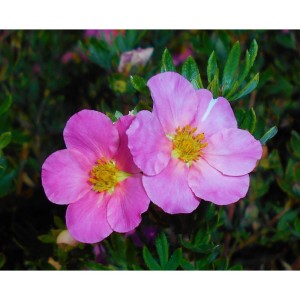Shrubby cinquefoil or Potentilla fruticosa is the rose’s often-overlooked relative. It boasts so many conspicuous virtues—hardiness, varmint-resistance, a repeat-blooming habit and beauty—but somehow it lacks the flash of the eternally beloved rose.
I am, of course, addicted to roses, but not long ago I finally bought a pink-flowered potentilla and now I wonder why I waited so long. It is a deciduous, many-branched shrub that grows to about three feet tall and two or three feet wide. Many contemporary varieties have a neat, mounding habit, but some sprawl in a ground-covering way that can be curbed by judicious staking. The foliage is beautiful. Each stem is adorned with deeply dissected leaves, which, to the casual observer appear as five-leaflet clusters. These are usually medium to dark green, but may also be grey-green or blue-green on some varieties. In fact, “cinqfoil”, the common name, means “five leaves”.
The flowers, which have five petals apiece, bear more than a passing resemblance to single roses, and usually feature yellow to golden stamens. Though relatively small at roughly one inch wide, they are available in a range of colors. The most common color is yellow, but the range includes just about every shade except for deepest purple and blue. Some of the red varieties change color from red to yellow as the blooms age. A healthy plant will cover itself with flowers at intervals throughout the growing season, arguably giving more value for the money than many roses.
Potentilla has been stars of the ornamental garden world for a long time. Nineteenth century plant breeding virtuoso, Victor Lemoine, who loved double flowers, bred the first double potentilla, which he called ‘Gloire de Nancy’. Though not commercially available today, it was a hit in its day. Double and single-flowered varieties have spent time in the horticultural spotlight, and then receded from popularity by turns. Right now, with the strong vogue for easy-care flowering shrubs, they are beginning to enjoy resurgence, with a host of varieties widely available.
When I want to assess a species’ popularity, I always turn to plant mega-wholesalers like Monrovia and Proven winners. Monrovia currently lists 14 different varieties and Proven Winners carries four. This means that you can obtain the plants readily at local nurseries and garden centers.
Sometimes it is hard to be spoiled for choice, when what you really want is just one or two really good varieties. If that is your plight in this life, start out with ‘Abbotswood’, which won the Royal Horticultural Society’s Award of Garden Merit in 1993, and is considered by many to be among the best white-flowered potentillas. It has the neat mounding habit that shouts “carefree” to gardeners, with the bonus of blue-green foliage. Like all potentillas, it will attract butterflies but not deer, rabbits or other predators of that ilk.
Breeders of modern potentillas generally aim for larger than average flowers and a tidy habit. Plants in the Happy Face series fit that bill. Flower colors for Happy Face ‘White’ and ‘Yellow’ are self evident. You can also buy ‘Pink Paradise’, with sweet, pink and white blossoms, or the more vivid ‘Hearts’, which blooms in a deeper rose shade. All feature green foliage.
Another longtime favorite is ‘Primrose Beauty’, with primrose yellow flowers and lovely grey-green foliage. If you are partial to the primrose color, but love the romantic look of double flowers, try the delicious-sounding “Lemon Meringue’.
Some of us yearn for drama in the garden, which is perfectly understandable, especially at times like the present, when life seems very constricted. Potentillas in the orange, red-orange and red color ranges will provide abundant flashes of bright light. Many people have commented on ‘Red Ace’, which is a color changer that moves from red to yellow. Something similar happens with ‘Marob’, sold as “Marian Red Robin”, which fades from red to orange. The latter has been recognized by the Royal Horticultural Society. The color changing phenomenon in potentillas is triggered by variations in temperature and day length.
‘Bella Sol’ opens yellow-orange and stays that way. ‘Twinkling Star’ has red to coral petals that catch the eye because of their larger than average size.
Like many other rose family members, potentillas like full sun—six hours or so per day—and well drained soil. They are not fans of hot, sticky summers, but can get through sultry periods with the application of consistent moisture. Mulching is helpful.
Use them as single specimens in mixed, annual/perennial/shrub borders, or as lovely, low hedges or garden room dividers. They are also excellent for pollinator gardens.
Well stocked nurseries and garden centers will probably offer at least one or two potentillas, especially if those retailers carry plants from Monrovia. For a good selection by mail order try ForestFarm, 14643 Water Gap Rd, Williams, OR 97544; (541) 846-7269; www.forestfarm.com.

